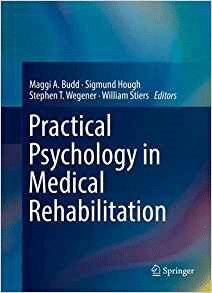“Practical Psychology in Medical Rehabilitation”

“Practical Psychology in Medical Rehabilitation”
Edited by Maggi A. Budd, Sigmund Hough, Stephen T. Wegener, and William Stiers
Springer International Publishing
Switzerland, 2017
Breadth of topics makes compilation impressive
By James K. Luiselli, Ed.D., ABPP, BCBA-D
Rehabilitation psychology has a long tradition in medical settings serving people with complex physical and cognitive impairments. This edited book was conceived as a “go to” information source for rehabilitation professionals representing behavioral medicine, health psychology and related disciplines.
The book is a robust compilation of 60 chapters distributed among six organizing sections: (1) basics and social practicalities, (2) populations, problems and procedures, (3) assessment and practical intervention, (4) consultation and advocacy, (5) practice management and administration, and (6) research and self-evaluation. At 595 pages, it is comprehensive, in depth and consistently satisfying.
Because the book’s editors wanted to “make the information rapidly accessible to busy practitioners,” they had chapter authors follow a common format, beginning with an initial section that introduces the topic and previews later sections. This particular format serves the reader well by synthesizing the most practice-relevant concepts and applications.
Next, the chapters examine the issue of “importance” or how does the topic pertain to psychology in medical rehabilitation? In most cases, this section includes liberal discussion of incidence statistics, guiding principles, quality of life indicators and symptom sequelae.
Section 3 of each chapter addresses practical use of diagnostic, assessment, treatment and management procedures. Rather than narrative presentation, the procedures are sequenced in outline form with central headings and clarifying sub-headings.
The fourth chapter section is a series of tips summarizing the preceding information and articulated as bullet points. There is a final section of publication references that direct further inquiry and analysis.
Concerning the problems and populations featured in the book, the range is expansive, covering traumatic brain injury, stroke, amputation, burns, transplants, cardiovascular disease, and pain, to name only a few.
Also, there are chapters that guide professionals in conducting consultation, collaborating with interdisciplinary teams, accessing research literature and even completing CPT and billing codes!
As might be expected with a book of this type, there is variability from chapter to chapter with regard to page length and the amount of detail contained in the chapter sections. For the most part, the writing is uniformly high level, not an easy accomplishment with more than 90 contributing authors.
For several reasons, this book is a must have resource for psychologists working in the field of medical rehabilitation. First, the breadth of topics is so inclusive that professionals are able to access information that informs virtually every practice domain.
Second, the editors achieved their goal of publishing a practitioner focused book. The chapters truly function as guides by listing clear directives and precise recommendations.
Finally, the uniform chapter format is most appealing and enables readers to move seamlessly between topics of interest. As noted, the outline format of the chapters consolidates the most critical practice considerations in a step-by-step structure.
I would add that the book is a wonderful example of interdisciplinary collaboration that is necessary for successful medical rehabilitation. Hospitals, treatment centers, long-term care facilities, and similar settings would do well to have multiple copies of the book on hand.
James K. Luiselli, Ed.D., ABPP, BCBA-D, is Chief Clinical Officer, Clinical Solutions, Inc. and North East Educational and Developmental Support Center, Tewksbury, Mass.
Learn more about the book: Practical Psychology in Medical Rehabilitation
